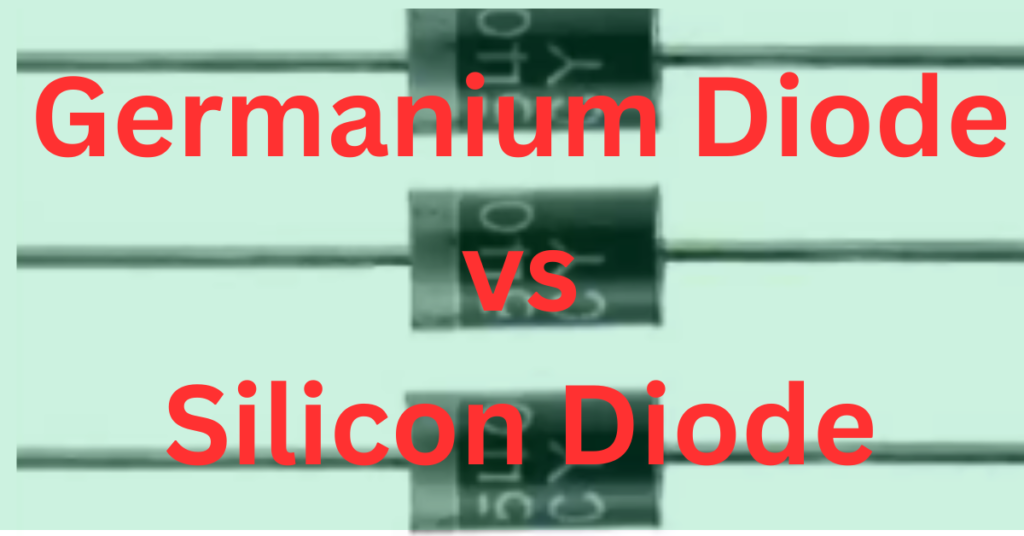This article explores the differences between silicon diode and germanium diode, focusing on their physical properties, performance characteristics, and typical applications. Diodes, essential components in electronics, are devices that allow current to flow in one direction but block it in the other. Two common types of diodes are silicon diodes and germanium diodes, each with distinct properties due to their different semiconductor materials: silicon and germanium.
Overview of Silicon Diode and Germanium Diode
Silicon diodes are made from silicon, a semiconductor material that is abundant and widely used in electronic components. Silicon diodes are known for their robustness and high-temperature resistance, making them suitable for various applications. Silicon diodes are ideal for rectification, signal modulation, and voltage regulation applications due to their high operating temperature range and high forward voltage drop. Typically, the forward voltage drop for a silicon diode is around 0.7 volts. Moreover, silicon diodes have better reverse recovery characteristics than germanium diodes. They can operate stably in high-temperature conditions, thanks to their high operating temperature range.
A germanium diode is a semiconductor diode made from germanium material. Just like a silicon diode, it is created by combining a p-type germanium material with an n-type germanium material. The forward voltage drop of a germanium diode is lower than that of a silicon diode, typically around 0.3 volts. This makes germanium diodes better suited for low voltage applications. However, the reverse leakage current of a germanium diode is higher than that of a silicon diode, so it is not suitable for high-temperature conditions. On the other hand, germanium diodes have a higher signal amplification coefficient, making them a good choice for signal amplification in small-signal amplifiers.
Key Differences
- Material: Silicon diodes are constructed from silicon, while germanium diodes are made from germanium. Each material gives the diode its unique characteristics.
- Forward Voltage Drop: Germanium diodes typically have a forward voltage drop of about 0.3 volts, which is lower than the approximately 0.7 volts for silicon diodes. This lower forward voltage drop makes germanium diodes more efficient in low-voltage applications.
- Leakage Current: Germanium diodes generally have higher leakage currents compared to silicon diodes, especially at higher temperatures. This makes silicon diodes more suitable for applications that require stability over a wider range of temperatures.
- Temperature Sensitivity: Silicon diodes can operate at higher temperatures than germanium diodes without performance degradation. Silicon diodes are typically rated for use at temperatures up to 175°C, whereas germanium diodes are limited to about 70°C.
- Switching Speed: Germanium diodes have faster switching speeds, which can be advantageous in high-frequency applications. However, modern manufacturing techniques have significantly improved the switching speeds of silicon diodes.
- Availability and Cost: Silicon diodes are more commonly used and produced, making them generally cheaper and more readily available than germanium diodes.

Comparison Table( Silicon vs Ge diode)
| Feature | Silicon Diode | Germanium Diode |
|---|---|---|
| Material | Silicon | Germanium |
| Forward Voltage Drop | Approximately 0.7 volts | Approximately 0.3 volts |
| Leakage Current | Low | High |
| Maximum Operating Temperature | Up to 175°C | Up to 70°C |
| Peak Inverse Voltage(PIV) | High PIV | Low PIV |
| Switching Speed | Moderately fast (improving with technology) | Fast |
| Signal amplification factor | Low | High |
| Reverse recovery time | Shorter | Longer |
| Reverse Saturation Current | Lower, typically 1 nA | Higher, typically 1000 nA |
| Effect of Electronic Noise | Less | More |
| Cost | Generally lower | Generally higher due to less common usage |
| Applications | rectification, signal modulation, and voltage regulation | small signal amplification, light sensing applications, and photodiodes, |
Conclusion
Choosing between a silicon diode and a germanium diode depends on the application’s specific requirements. Silicon diodes are more versatile and suitable for a broader range of applications due to their higher temperature tolerance and lower leakage currents. Germanium diodes, while somewhat niche, are preferred in applications where low forward voltage and high-speed switching are critical. Understanding the differences between these diodes allows engineers to optimize their electronic designs for performance, cost, and durability.